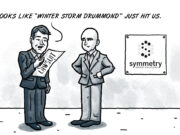
(Editor’s note: This story was authored by Jennifer Palmer of Oklahoma Watch and appears here in accordance with the non-profit journalism organization’s republishing terms.)
In schools across the nation, including in Oklahoma, children whose school meal accounts aren’t paid in full sometimes face embarrassment in the cafeteria line.
Some schools take away their trays and give them an alternative meal, like a cold sandwich. Others put a stamp on their hand that reads “lunch money” as an alert to parents but also visible to peers.
Practices such as these, called “lunch shaming,” have triggered parent backlash in some districts, including at least two in Oklahoma. The practice was recently banned in New Mexico, and Texas and California are considering similar laws.
A few weeks ago, the Choctaw-Nicoma Park School District halted its practice of stamping the hands of children who owe lunch money after an outcry from parents.
Harrah Public Schools faced scrutiny recently when a substitute cafeteria worker took hot meals from children whose accounts were empty; the children received a cold sandwich to eat instead.
State lacks protocol for unpaid lunches
Oklahoma schools are allowed to take these actions because the state does not have a policy on how to treat non-paying students, letting districts decide for themselves.
Chris Bernard, executive director of nonprofit Hunger Free Oklahoma, said inferior meals, hand stamps and chores for students with meal debt unnecessarily humiliate children, which can lead to them being bullied or picked on and cause mental health issues.
“(Schools) need to be thinking about practices that are not singling out children for something they absolutely have no control over and potentially putting them in a situation where they don’t have the nourishment they need to be successful in school,” Bernard said.
The students affected by these policies typically don’t qualify for the federal free-lunch program, although there may be some whose parents decline to apply. Still, there are often family circumstances behind meal debt, such as a parent losing a job, or working intermittently, or other financial setbacks.
Unpaid lunch tabs add up
But some school officials say lunch programs are costly to run, and unpaid meal debt is a problem they have to address. The debt can accumulate into thousands of dollars by the end of the school year.
The lunchtime incident at Harrah was handled improperly, said Harrah superintendent Paul Blessington, because students should have been identified before receiving the hot meal. By policy, students with unpaid charges are provided an alternative meal of a sandwich, fruit and drink.
The situation is difficult for a district like Harrah where about half the students qualify for free or reduced-price lunches but the other half pays full price, he said. Nationally, lunches cost about $2.50 each on average.
Blessington said the district can’t absorb thousands in unpaid lunch bills; the 2,200-student district has accumulated over $2,000 in unpaid meals this year.
At Choctaw-Nicoma Park, students’ hands were stamped only after accumulating a negative balance of more than $5 and the school had taken other steps to let families know of the unpaid charges, a school official said. Parents complained, however, and the practice was discontinued several weeks ago.
‘Dignity of our students comes first’
Unpaid meal debt is less of an issue at large urban school districts where most students receive free meals.
All of Tulsa Public Schools’ elementary students eat free. But middle-school students with more than $8.40 in unpaid charges receive an alternative meal, which is just half a cheese sandwich and water for lunch and a piece of toast or graham crackers for breakfast. High school students who can’t pay receive nothing.
That’s the official policy, but it is likely not enforced in schools out of compassion for the students, said Emma Garrett-Nelson, a district spokeswoman.
“Our guidance that we give to our cafeteria workers is the dignity of our students comes first,” Garrett-Nelson said.
USDA sets July 1 deadline for policies
Schools are expected to examine their lunch policies now because the U.S. Department of Agriculture, which administers school meal programs, has asked states to define their policies by July 1. Oklahoma doesn’t have a statewide policy, but local school districts will still have to submit a plan to the state Department of Education.
One recommendation by the Agriculture Department is to have schools move the cashier to the front of the lunch line to prevent situations where a child’s meal is taken away because they can’t pay, allowing staff to address the issue discreetly.
That practice — trashing lunches served to students who can’t pay — is now banned under New Mexico’s Hunger-Free Students’ Bill of Rights Act. The legislation, which was signed into law in April and is the first of its kind in the country, requires schools to give all students access to the same lunch regardless of ability to pay and prohibits schools from having students to do chores to work off debt.
The lawmaker who introduced it, New Mexico Sen. Michael Padilla, had to mop the floors of his school cafeteria when he couldn’t afford lunch, according to an NPR story.





















